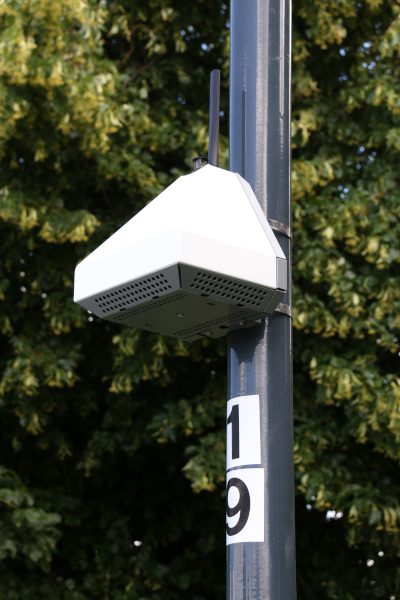
2022 marked 10 years of innovation and leadership from AQMesh. To highlight the group’s experience, ongoing forward-thinking and its commitment to pushing the capabilities of small sensor systems, here the firm lists the top 10 things AQMesh developed first and refined since it commercially launched in 2012.
1. IoT connectivity using the mobile phone network: remote data for small sensor air quality monitoring
AQMesh was the first small sensor manufacturer to adopt an IoT approach, using the mobile phone network to connect with the cloud, allowing remote access of data from individual measurement points. Until then, conventional equipment used loggers and other early small sensor air quality equipment offered direct download or radio communication, often across a group of sensor nodes.
2. Integration of gas and PM monitoring in a single small sensor instrument
Since 2013, AQMesh pods have been able to monitor gases and particles in one instrument. The compact pods have continued to lead in terms of the wide range of measurements offered on a single unit: up to six gases out of NO, NO2, O3, CO, SO2, H2S, TVOC and CO2 as well as PM monitoring and options for noise and wind speed/direction. Pressure, relative humidity and pod temperature are all measured as standard. In the 2019 AIRLAB International Microsensors Challenge, AQMesh was recognised as the most accurate multi-parameter outdoor air quality monitor, and was evaluated for the highest number of pollutant measurements offered within a single system.
3. Mini optical particle counter, counting and sorting particles by size, for accuracy across all PM fractions
AQMesh’s in-house designed optical particle counter measures particulates PM1, PM2.5, PM10, TPC and TSP (up to 30 microns). Its bespoke design uses a straight line between the sample inlet and bench, meaning larger particles do not settle in a bent sample path, allowing for complete capture of pollutants. Additionally, the OPC uses a pump instead of a fan, which produces a steady flow from inlet to sample measurement, and subsequently provides consistency for the sample calculations – fans can cause vacuums which could interfere with the flow rate and affect the sample measurement. The AQMesh OPC therefore allows more coarse particles (PM10) in the sample to be accurately measured.
4. Pioneers of city-wide small sensor networks from Citi-Sense to the Breathe London Pilot
Initiated in 2012, AQMesh was part of the EU-funded consortium which set up a ground-breaking project to advise citizens about air quality, across eight cities, using hundreds of measurement devices. The Breathe London pilot, which ran from 2018 to 2020, and in which 100 AQMesh pods were used, was the world’s first hyperlocal monitoring network. The two year pilot project proved & validated small sensors for city-wide monitoring, and also led to the Environmental Defense Fund (EDF) publishing a ‘blueprint’ for other cities.
5. Real-time out-of-the-box accuracy with correction for environmental conditions and cross-gas effects without the need for machine learning
AQMesh’s high accuracy and performance has been achieved through years of extensive global co-location comparison trials against certified reference equipment, in all seasons, meaning AQMesh can accurately operate in the widest possible range of environments and conditions. No other manufacturer has access to the wealth of data that AQMesh has gathered. With these datasets AQMesh has been able to develop meaningful correction of cross-gas effects and interference from environmental conditions through its fully traceable data processing algorithms.
6. ‘Gold pod’ approach
The ‘gold pod’ approach, as originally described by the AQMesh team, involves one unit being co-located with and scaled against a maintained reference station and then moved around a network of nodes to calibrate each of the other units. This method has now been widely adopted and offers an effective way to improve accuracy and achieve traceability. It was back in 2017 when Professor Rod Jones from the University of Cambridge presented the results of the ‘gold pod’ approach in which 20 AQMesh pods were deployed across Cambridge after co-locating one with reference, and he commented at the time “Because we know that all the pods read the same and because we have a comparison between one pod and a reference instrument we can say that all pods are working equivalently across the city.”
7. White reflective sunshield and insulation for temperature management
The sunshield was first added to AQMesh pods in 2013 to minimise the impact of direct sunlight on pod sensors. Various solutions were tested – for active or passive cooling – and AQMesh’s reflective shield, insulation and air flow gap was found to be most effective at minimising the challenge to temperature stability from strong, direct sunshine.
8. Promote rigorous QA/QC and offer feasible methods to achieve it
Since 2015, the AQMesh onsite reference station means each sensor has been tested through a rigorous quality control process before it leaves the UK factory. The custom-built enclosure uses climate-controlled reference/equivalence analysers sampling air from an ambient cage which can hold up to 100 AQMesh pods at a time. This ambient characterisation during manufacture is part of a stringent AQMesh quality assurance process, which also includes strict criteria for PM, so every AQMesh pod out in the field to date has been through specific quality control measures to ensure the efficiency and reliability of each sensor in real-world conditions. QA/QC doesn’t end at the factory either; the AQMesh team regularly offer remote QA/QC of data once pods are out in the field.
9. CO2 emissions profiling
AQMesh can offer incredibly high out-of-the-box accuracy (typically less than 15% uncertainty) for CO2 monitoring. Using this reliable data, AQMesh can be used for CO2 source apportionment, and measuring alongside NO and NO2 can allow for emissions profiles for different locations to be determined. This means the combustion contributing to the pollution can be specifically identified; such as whether there is either gas or diesel traffic, which is only possible with such accurate data.
10. Long distance scaling
The Breathe London pilot showed how pods could be traceably scaled across a city, using a novel approach pioneered by partners at the University of Cambridge. This technique, which reduces the field demands of the proven gold pod approach, requires basic measurement data of a good quality in order to be effective, and AQMesh have built on the initial Breathe London methodology with their own simplified Long Distance Scaling tool.
For more information about AQMesh contact them today or visit www.aqmesh.com.






